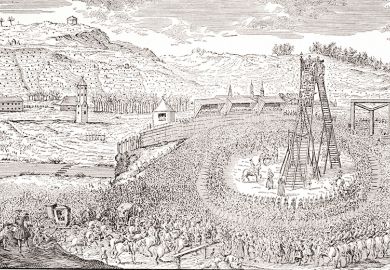In a draft of a late essay, Virginia Woolf declared that “It was the printing press that finally was to kill Anon…” As with many of Woolf’s pronouncements, there is a seductive certainty that belies the tendentiousness of the claim. She was wrong about the death of the unnamed author with the advent of print; we now know that anonymous publication continued long into the era of the letterpress and the professional named author. But she is interesting on the link between print and authorial self-presentation: “The printing press brought into existence…the man who first sees himself and shows himself to us.”
Mark Vareschi’s account of 18th-century anonymity in print, Everywhere and Nowhere, has none of the nostalgia of Woolf’s account of the demise of the minstrel “Anon”. His methodology is drawn from media theory and distant reading, and he explores parallels with contemporary digital circulation. Yet he circles around the area that Woolf inhabits: the shifting relationship between authorial identity, forms of circulation and the changing nature of agency.
Anonymous publication leaves us at a loss as to how to ascribe intention within a literary work. Vareschi argues that the concept of mediation, derived from media theory, foregrounds the multiple agents and actions that determine the production, circulation and reception of a work. And mediation and anonymity operate differently according to genre. So, for example, late 18th-century elocutionary primers are composed of a range of textual extracts not attributed to an author (even when the author was known). The emphasis within these collections was on the role of the reader, or performer, as interpreter and mediator of the piece, which made the author much less relevant. Exploring Daniel Defoe’s works, Vareschi shows how the ascendancy of his reputation as a canonical author encouraged publishers posthumously to attribute anonymous works to the novelist. In this case, he claims, books, through their circulation, make authors.
Vareschi’s argument is made on slightly thin grounds: there is a limited amount of quantitative analysis of anonymous book publication. He illustrates the generic differences between verse, drama and prose fiction through a few case studies. This is not systematic bibliometric or literary critical analysis. But it does offer a way of thinking afresh about some of the more tired debates of 20th-century literary studies – the intentional fallacy, the death of the author – and to revisit them in the era of the history of the book and digital humanities. Perhaps more surprising, it reminds us that what might seem like the theoretical suppositions of our own moment were fairly commonplace in the 18th century. The it-narratives of the era told stories of objects with their own agency, while Jonathan Swift playfully imagined a version of the death of the author: “when Virgil is mentioned, we are not to imagine the Person of a famous Poet, call’d by that Name, but only certain Sheets of Paper, bound up in Leather, containing in Print, the Works of the said Poet”.
Abigail Williams is professor of 18th-century studies at the University of Oxford and the author of The Social Life of Books: Reading Together in the Eighteenth-Century Home (2017).
Everywhere and Nowhere: Anonymity and Mediation in Eighteenth-Century Britain
By Mark Vareschi
University of Minnesota Press
230pp, £83.00 and £19.99
ISBN 9781517904067 and 9781517904074
Published 1 December 2018
Register to continue
Why register?
- Registration is free and only takes a moment
- Once registered, you can read 3 articles a month
- Sign up for our newsletter
Subscribe
Or subscribe for unlimited access to:
- Unlimited access to news, views, insights & reviews
- Digital editions
- Digital access to THE’s university and college rankings analysis
Already registered or a current subscriber?








